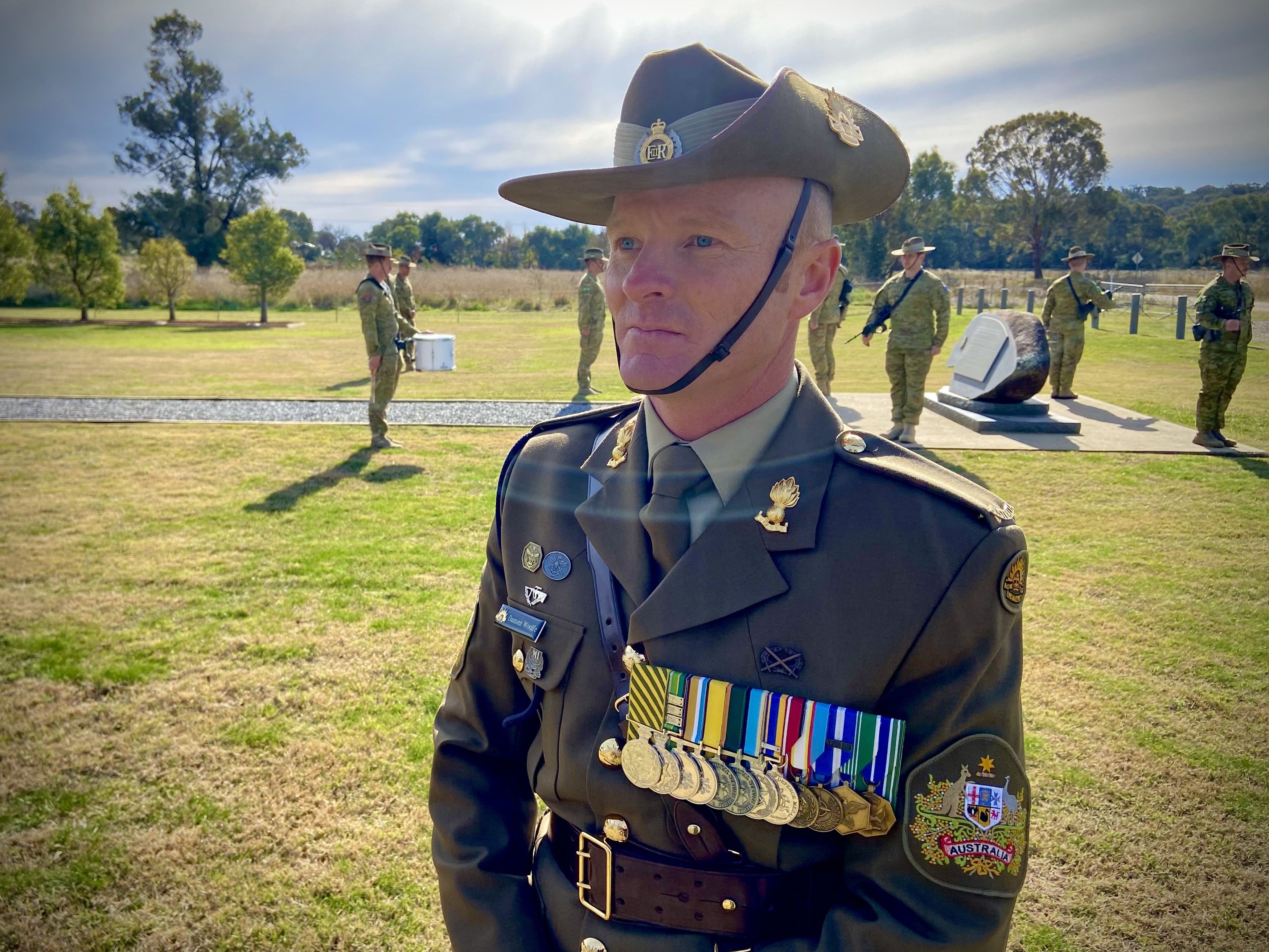
RSM Damien Woolfe prepares for the Kapooka Training Accident memorial ceremony. Photo: Chris Roe.
Sergeant Colin Kendall was just metres from the dugout when it exploded.
It was mid-afternoon on Monday, 21 May 1945. Kendall and his fellow instructors were overseeing a group of trainee sappers as they learned to use explosives in a semi-underground bunker at Kapooka.
As Sergeant Jack Pomeroy demonstrated the setting of fuses, Kendal stepped out to check on another group nearby.
Minutes later as he returned, a deafening blast and a wave of searing heat lifted him off his feet.
As the smoke and dust cleared, he found himself surrounded by debris and gore.
“From my position on the ground, I could see that the dugout roof had caved in and a portion of a man’s body had been blown to a position close to me,” Kendall recalled.
He and a hastily assembled rescue team scrambled into the ruined bunker searching for survivors amid the carnage.
Seven corpses remained intact, still seated with arms folded, their skin ashen grey, appearing aged beyond their years. Most were unrecognisable.
One rescuer approached a body embedded deep into the clay of the southwestern wall, only to recoil in fright when “the bastard moved!”.
Sapper Allen Bartlett was severely burned and profoundly deaf but alive. He would be the only one of the 27 men caught in the blast to survive.
The Kapooka Tragedy remains the Australian Army’s largest loss of life in a training accident and the largest mass military funeral on Australian soil.
But when Japan surrendered just months later and war-weary Australians looked toward a brighter future, the incident at Kapooka began to fade from collective memory.

The aftermath of the dugout explosion that killed 26 young soldiers in 1945. Photo: NAA.
More than 50 years later, a researcher from Charles Sturt University was walking through the cemetery when a collection of graves caught his attention.
“It’s sort of a morbid thing historians do. You get a feel for a town by looking at graves,” Dr Peter Rushbrook explains.
“They’ve got Commonwealth War Graves there and I saw all these people who died on the same day and that’s interesting.”
It was the beginning of a journey for Dr Rushbrook as he delved deeper into the story and began to piece together a timeline and a narrative around the event and its aftermath.
As journalists, historians and eventually the Army took an interest in his work, Dr Rushbrook – now with RMIT in Melbourne – says they began to restore this forgotten tragedy to the nation’s “social memory”.
“Someone at the army base at Kapooka read the article, contacted the Uni, and said, ‘what’s going on? We’ve never heard about this!’ So the year after that, they held the first ceremony,” he says.
The first memorial took place in 2008 and has been held on 21 May every year since except for 2020 during the COVID-19 pandemic.

Soldiers prepare to mark the 77th anniversary of the Kapooka Tragedy. Photo: Chris Roe.
“If you don’t rehearse a social memory, if you don’t do what they do now and honour those guys every year through a ceremony, it’ll slip away,” Dr Rushbrook says.
As soldiers prepared for the 2022 ceremony held on the weekend, RSM Damien Woolfe says it represents an enduring bond between the military base and the wider community.
“It’s important to remember those 26 lives that were lost and acknowledge the risks that exist in training from 1945 to today,” he says.
“It’s also a reflection of the link between the Wagga community and Kapooka that still exists.”
Dr Rushbrook says the memory of the tragedy should inform the present.
“This is probably the first historical example of an OHS incident and it led to all kinds of reform,” he says.
“It was a classic example of what an accident is. Just one or two little things playing together at the wrong time and it led to the explosion.”
RSM Woolfe says this year’s ceremony would be particularly poignant for “the Army’s newest sapper,” who marched out at Kapooka on the Friday before the ceremony.
“From his perspective, I’m sure it’ll be a very sobering occasion.”
Lest we forget.








